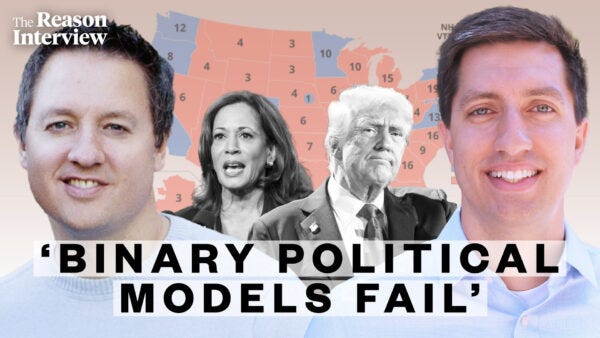How To Better Understand the New GOP & Old Democratic Party
The Myth of Left & Right authors Hyrum Lewis and Verlan Lewis explain how talking about politics on a spectrum confuses rather than clarifies—now more than ever!
Scroll down to start listening immediately!
This week’s Reason Interview podcast is with the authors of one of the best political books I’ve read in forever. Last year, brothers (and college profs) Hyrum Lewis and Verlan Lewis published The Myth of Left and Right: How the Political Spectrum Misleads and Harms America, which helps explain why increasing numbers of us are dissatisfied with the “bundles” of positions we’re being offered by the two major parties.
There’s no good or necessary reason, they argue, that people who want, say, lower marginal tax rates need to be in the same party as people pushing anti-flag-burning laws. Nor is it obviously clear why people who might be in favor of unions would also be in favor of robust protections of online free speech. How any of these positions might mesh with foreign policy is something else altogether.
The whole point of ideology and party rhetoric, they say, is to paper over all the massive differences within the different special-interest groups that comprise Republicans or Democrats, two parties whose identities gradually shift every generation or so. They also point to research showing that once people have picked a team or a tribe, they tend to change their positions when their party does. Which helps to explain how conservatives, who only a decade ago were massively in favor of free trade, are now embracing tariffs in a big way.
As it happens, the recent election illuminates what the Lewis brothers are talking about in two big ways. First, more and more people are disaffiliating with the Republicans and Democrats and for the first time in recent history (and maybe ever), self-identified independents made up a bigger share of the vote than Democrats. According to exit polls, Republicans made up 35 percent of the electorate, independents 34 percent, and Democrats just 31 percent. At the same time, Donald Trump made historic gains among Latinos, African Americans, and other ethnic groups—especially Native Americans. These are voting blocs that were never seen as up for grabs but now seem to be in play. Across many demographics, geographics, and psychographics, we care less and less for the bundles of policy positions the major parties are offering.
All of this suggests that viewing politics through the lens of left/right will yield less and less insight.
Here is the Reason Interview with Hyrum Lewis and Verlan Lewis. Below the YouTube, Apple, Spotify, and SoundCloud links is a list of topics.
0:00- Introduction
0:53- The Myth Of Left And Right
7:19- Politics is getting more rigidly polarized
9:50- Has the Republican Party become ‘far right’?
14:09- Politics are granular, not binary
19:20- People are more loyal to parties than positions
21:41- Trajectory of the Democratic Party
26:40- Democrats must embrace pluralism to win
31:05- Pluralism vs. Monism
32:37- Ad: ZBiotics
34:23- Trajectory of the Republican Party
37:33- How do RFK Jr and third parties fit into all this?
42:02- Backgrounds of the Lewis brothers
43:38- Political parties today function like churches
48:06- Why do the major parties flip flop so much?
53:47- There has never been a liberal or conservative consensus
58:51- Does the left hate America?
1:02:28- Finding hope against cynicism in American politics
If you like what I’m doing, please read Reason, the magazine of ‘free minds and free markets’ and my professional home for the past 31 years! Established in 1968 as a monthly magazine, Reason is the planet’s leading source for politics, culture, and ideas from a libertarian perspective. Every day, we’re posting new articles, podcasts, video, and other content that contravenes the very binary discussed in today’s Interview.

